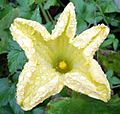Cucurbita ficifolia facts for kids
Quick facts for kids Cucurbita ficifolia |
|
|---|---|
 |
|
| Scientific classification | |
| Genus: |
Cucurbita
|
| Species: |
ficifolia
|
| Synonyms | |
|
|
The Cucurbita ficifolia is a type of squash. People grow it for its tasty seeds, fruit, and green leaves. It has many common names in English. Some of these names are fig-leaf gourd, Malabar gourd, black seed squash, and cidra. Even though it is related to other squashes like the pumpkin, it is quite different. It does not easily mix with them to create new types.
Contents
What is the Fig-Leaf Gourd?
The fig-leaf gourd is a climbing plant. It grows like a vine. In warm places, it can live for many years. In colder areas, it grows for one year and then dies. Unlike some other squashes, it does not have big roots that store food.
How Does the Plant Grow?
The plant's stem can grow very long, from 5 to 15 meters (about 16 to 49 feet). It has thin parts called tendrils. These tendrils help the plant climb on other plants or structures. Its leaves look like fig leaves. This is why it is called the fig-leaf gourd. The Latin name C. ficifolia also means "fig leaf."
What Do the Flowers and Fruit Look Like?
The plant has both male and female flowers on the same plant. Bees and other insects help pollinate them. The flowers are yellow or orange.
The fruit is shaped like an oval, similar to a watermelon. It is about 20 centimeters (8 inches) wide. Each fruit weighs about 5 to 6 kilograms (11 to 13 pounds). It can have up to 500 large black seeds inside. The skin of the fruit can be light green, dark green, or cream colored. One plant can grow more than 50 fruits! If you keep the fruit dry after picking it, it can last for several years without going bad.
Where Does the Fig-Leaf Gourd Come From?
This squash first grew in the Americas. We are not sure exactly where it was first grown by people. Some clues point to Mexico. Many names for it, like "chilacayohtli," come from the Nahuatl language. This name is used as far south as Argentina.
However, old findings suggest Peru. The oldest remains of this plant have been found there. Scientists are still trying to figure out its exact origin.
How Did It Spread Around the World?
Old records show that this squash was very common in the Americas. People grew it from northern Chile all the way to Mexico. Today, it grows as far north as southern California. In the 1500s and 1600s, Europeans brought it to places like France, Portugal, and India. From there, it spread to many other parts of the world.
How to Grow Fig-Leaf Gourd
The fig-leaf gourd grows well in cool, high places. It can grow at heights up to 2,000 meters (about 6,500 feet). Farmers often use it as a base for other squashes. This helps the other squashes grow stronger.
You can grow C. ficifolia from its seeds. You can also grow it by a method called layering. This is when a part of the plant, like a tendril, grows roots if it touches the soil. Once it has roots, you can cut it and plant it somewhere else. This plant does not like frost very much. So, it is usually planted after the danger of frost has passed. But once the plants are strong, they can handle short cold nights.
What Are the Uses of Fig-Leaf Gourd?
People use different parts of the fig-leaf gourd for food.
Eating the Plant
In Mexico and other countries, people eat the flowers, leaves, and young shoots. They use them as green vegetables. The most nutritious part of the plant is its seeds. These seeds are rich in fat and protein. They can be white or black. In Mexico, people use the seeds to make a sweet treat called palanqueta. It is similar to peanut brittle.
The fruit is also used in many ways. Young fruits can be cooked and eaten. Ripe fruits are sweet. They are used to make sweets and drinks. Some drinks can even be alcoholic. The fruit does not have much beta-carotene, which is why its flesh is white. It also has low amounts of vitamins and minerals. However, it is moderately high in carbohydrates.
Traditional Dishes and Health Benefits
In Spain, this squash is used to make a jam called "cabello de ángel" (angel's hair). This jam is used to fill pies and other sweets. In Portugal, it is called "chila" or "gila." It is still used a lot in traditional Portuguese sweets. It was also used to feed pigs.
In Chile, people often make jam from the fruit. In Costa Rica, it is common to make empanadas (pastries) filled with sweetened squash during Easter.
In Asia, the stringy inside of the fruit is used to make soup. This soup looks a lot like shark fin soup. That is why it is sometimes called "shark's fin melon." Eating this squash is also believed to help people with diabetes in Asia. Some scientific studies have shown that it can help lower blood sugar. It is used to treat diabetes because it has a lot of D-Chiro-Inositol.
The vine and fruit are also used as fodder to feed animals.
Images for kids
See also
 In Spanish: Chilacayote para niños
In Spanish: Chilacayote para niños





